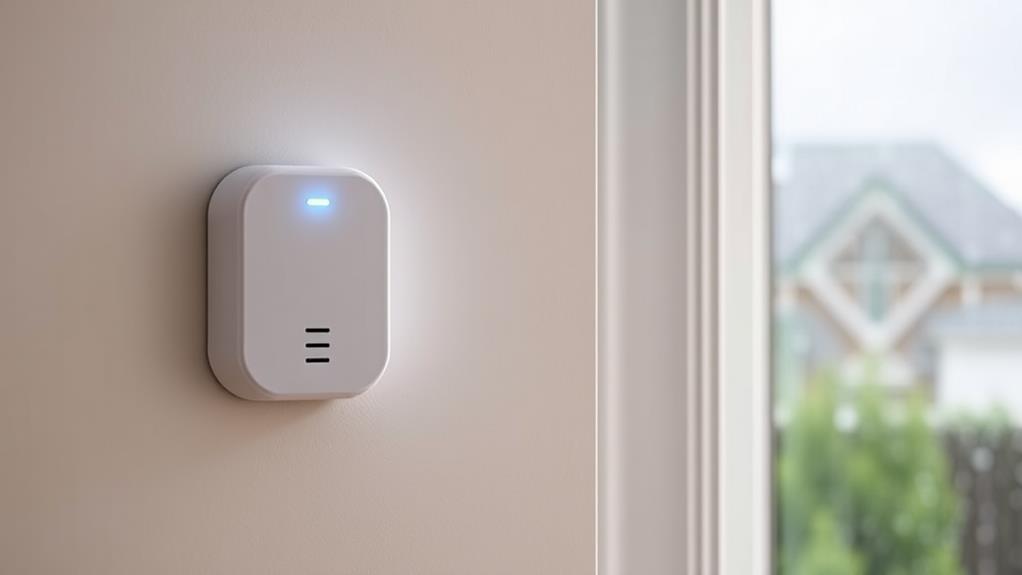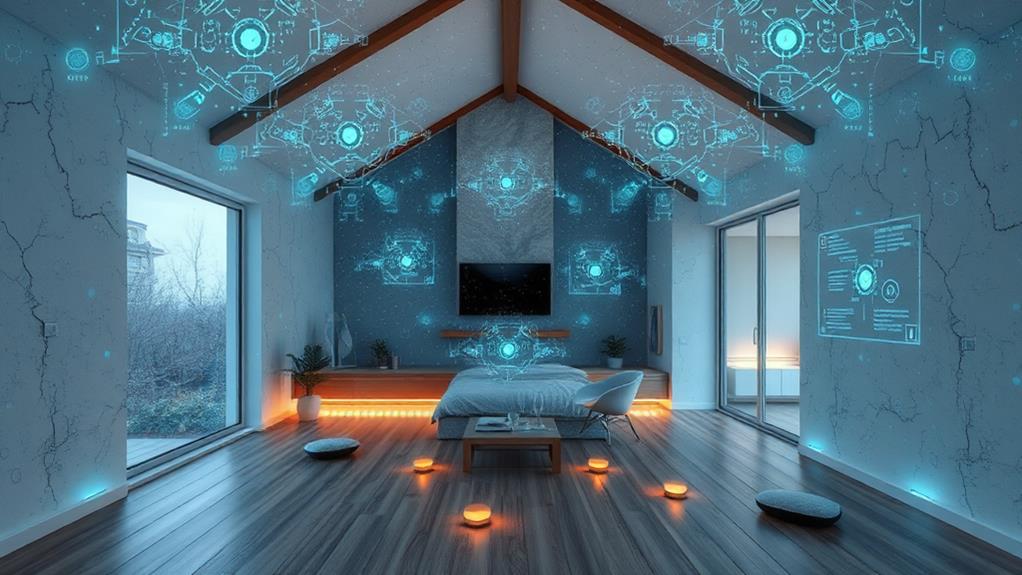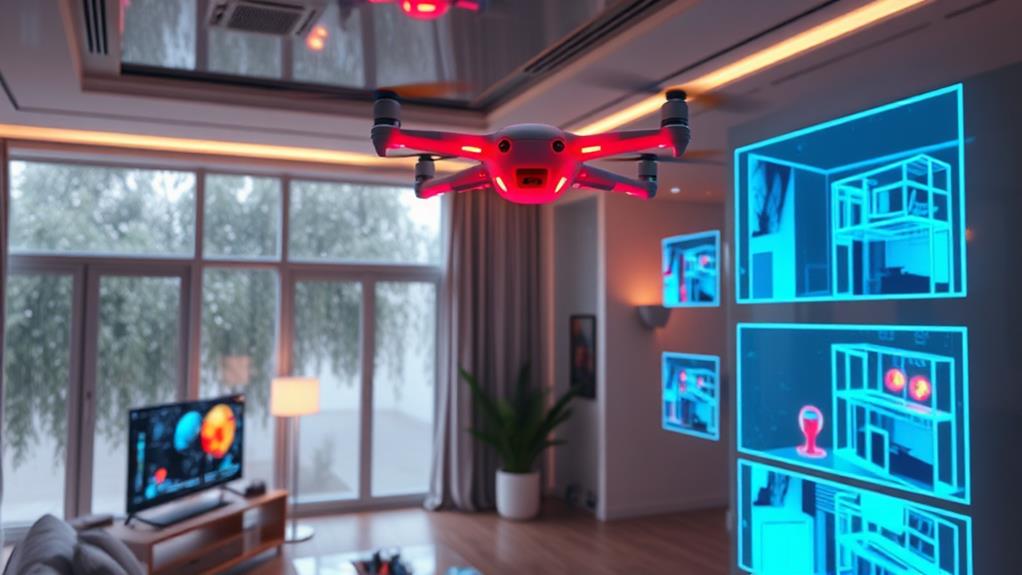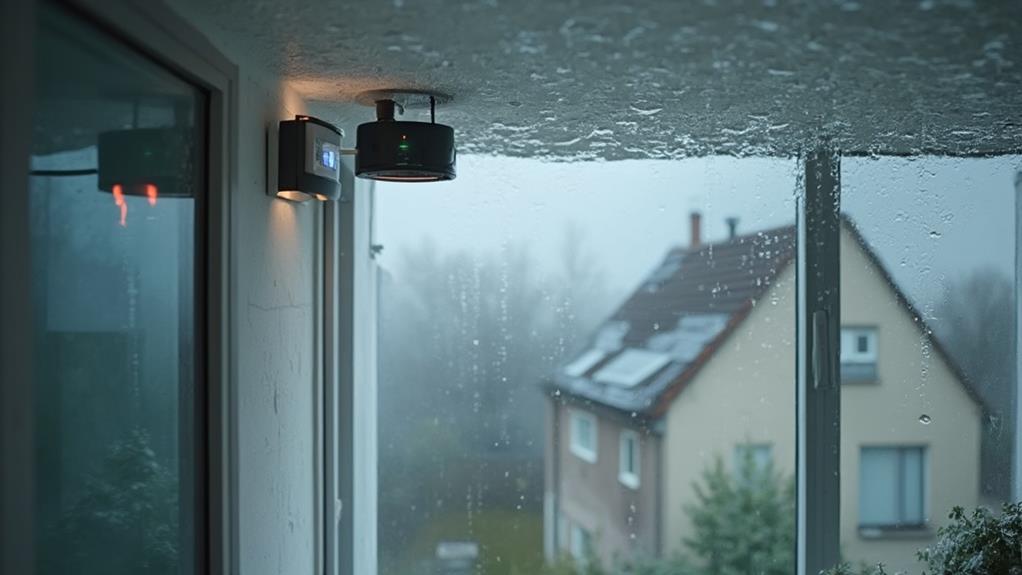Smart home technology provides powerful tools for detecting post-storm structural issues. Moisture sensors identify hidden leaks, while smart cameras with AI analyze exterior changes. IoT devices monitor structural integrity through vibration, moisture, and tilt sensors. Integration with local weather stations offers real-time data and predictive capabilities. AI-powered damage assessment tools analyze patterns, assess risks, and recommend preventive measures. These interconnected systems provide homeowners with comprehensive monitoring, early warning alerts, and detailed damage assessments. By leveraging this technology, homeowners can quickly identify and address potential problems before they escalate into costly repairs. The following sections explore these innovative solutions in greater depth.
Moisture Sensors for Hidden Leaks

Moisture-detection technology plays a crucial role in identifying hidden leaks after storms. These advanced sensors are designed to detect moisture levels in areas prone to water damage, such as walls, ceilings, and floors. By strategically placing these devices throughout the home, homeowners can receive early warnings of potential water intrusion before visible signs appear.
Modern moisture sensors utilize wireless technology to communicate with smart home systems, sending real-time alerts to smartphones or control panels when abnormal humidity levels are detected. This immediate notification allows for prompt investigation and remediation, potentially preventing extensive structural damage and mold growth.
Some sophisticated moisture sensors incorporate temperature monitoring capabilities, helping to identify areas where condensation may occur due to temperature differentials. This feature is particularly useful in detecting leaks in pipes hidden within walls or in attic spaces.
Integration with smart home ecosystems enables these sensors to trigger automated responses, such as shutting off the main water supply or activating dehumidifiers when moisture levels exceed preset thresholds. This proactive approach to moisture management can significantly reduce the risk of long-term structural issues and costly repairs following severe weather events.
Smart Cameras for Exterior Shifts
While internal moisture detection is vital, monitoring exterior structural changes is equally important in post-storm damage assessment. Smart cameras equipped with advanced image recognition technology can play a crucial role in identifying shifts or damages to a home's exterior structure.
These cameras can be programmed to continuously scan the property, comparing current images with pre-storm baseline footage. They can detect subtle changes in the building's facade, foundation, roof, or surrounding landscape that may indicate potential structural issues. For instance, they can identify new cracks in walls, shifts in roofing materials, or changes in the ground level around the foundation.
Many smart camera systems integrate with home automation platforms, allowing homeowners to receive real-time alerts on their smartphones when significant changes are detected. Some advanced systems even use artificial intelligence to analyze the severity of observed changes and provide recommendations for immediate action or professional assessment.
Structural Monitoring With Iot Devices

Building upon the capabilities of smart cameras, Internet of Things (IoT) devices offer a comprehensive approach to structural monitoring in post-storm scenarios. These interconnected sensors can be strategically placed throughout a home to detect and report on various structural indicators.
Vibration sensors can identify unusual movements or shifts in the foundation or walls, potentially signaling structural weaknesses. Moisture detectors placed in walls, attics, and basements can alert homeowners to water intrusion, which may lead to mold growth or structural decay if left unchecked. Tilt sensors can monitor the angle of walls and floors, detecting any deviations from their normal positions that might indicate settling or other structural issues.
IoT devices can also include smart utility meters that track changes in water, gas, or electrical consumption patterns, which could indicate leaks or damage to these systems. All data collected by these sensors is transmitted to a central hub or smartphone app, providing real-time monitoring and alerts. This integrated system allows homeowners to quickly identify and address potential structural problems before they escalate, enhancing both safety and property value preservation in the aftermath of severe weather events.
Weather Stations and Climate Data
Weather stations and climate data play a significant role in assessing and predicting structural risks associated with severe weather events. By integrating smart home systems with local weather stations and climate databases, homeowners can receive real-time information about approaching storms, wind speeds, precipitation levels, and temperature fluctuations. This data enables proactive measures to protect the structural integrity of homes.
Advanced weather stations can provide hyperlocal data, offering more accurate predictions than general forecasts. When connected to smart home systems, they can trigger automated responses such as closing storm shutters, adjusting HVAC systems, or activating sump pumps before severe weather hits. Historical climate data, combined with current readings, allows for trend analysis and long-term risk assessment. This information is valuable for planning preventive maintenance and structural reinforcements.
Moreover, weather stations can monitor post-storm conditions, tracking factors like humidity levels that may impact structural materials. By correlating weather data with structural monitoring systems, homeowners and professionals can better understand the relationship between environmental factors and building performance, leading to more effective strategies for maintaining structural integrity in the face of extreme weather events.
AI-Powered Damage Assessment Tools

Leveraging cutting-edge technology, AI-powered damage assessment tools have revolutionized the way structural issues are detected and evaluated after severe weather events. These sophisticated systems utilize machine learning algorithms and computer vision to analyze images and data collected from various sources, including drones, satellites, and ground-based sensors.
AI algorithms can quickly process vast amounts of information, identifying potential damage patterns and structural weaknesses that might be overlooked by human inspectors. These tools can assess roof integrity, foundation stability, and exterior wall conditions, providing homeowners and insurance companies with detailed reports and actionable insights.
Some AI-powered platforms incorporate historical data and predictive modeling to estimate the likelihood of future damage based on current conditions. This proactive approach allows homeowners to take preventive measures and reinforce vulnerable areas before the next storm hits.
Additionally, these tools can integrate with smart home systems, enabling real-time monitoring and alerts. By combining AI analysis with data from connected sensors throughout the home, homeowners can receive immediate notifications about potential structural issues, allowing for prompt intervention and minimizing long-term damage.
Integration With Insurance Claim Processes
The integration of AI-powered damage assessment tools with insurance claim processes has streamlined and expedited the often complex and time-consuming task of filing and processing claims after a storm. These advanced systems can automatically generate detailed reports of structural damage, complete with photographic evidence and precise measurements, which can be directly submitted to insurance providers.
This seamless integration allows homeowners to initiate claims faster, reducing the wait time for adjusters and potentially accelerating the overall claims process. Insurance companies benefit from more accurate and consistent damage assessments, minimizing the risk of fraud and enabling more efficient resource allocation.
Some smart home systems can even interface directly with insurance company databases, providing real-time updates on claim status and facilitating communication between homeowners and insurers. This level of integration not only improves the customer experience but also helps insurance companies manage their workload more effectively.
Additionally, the historical data collected by these AI systems can be valuable for risk assessment and policy pricing, potentially leading to more tailored and fair insurance premiums for homeowners based on their property's actual resilience to storm damage.
Frequently Asked Questions
How Much Does a Smart Home Technology System Typically Cost?
The cost of a smart home technology system varies widely, typically ranging from $500 to $5,000 or more. Factors influencing price include the system's complexity, number of devices, integration capabilities, and installation requirements.
Can Smart Home Devices Detect Mold Growth After Water Damage?
������ Smart home devices can indeed detect mold growth after water damage. Utilizing advanced sensors, these systems monitor humidity levels and moisture content in walls and floors, alerting homeowners to potential mold-prone conditions before visible growth occurs.
Are Smart Home Systems Vulnerable to Hacking During Power Outages?
Smart home systems can be vulnerable to hacking during power outages, especially if backup power sources are compromised. Without proper security measures, offline devices may be susceptible to local attacks. Implementing robust cybersecurity protocols is crucial to mitigate these risks.
Can These Technologies Differentiate Between Storm Damage and Normal Wear and Tear?
Picture a home inspector with X-ray vision—that's smart tech for you. While these systems can detect anomalies, differentiating storm damage from normal wear often requires human expertise. Advanced AI is improving, but interpretation remains key.
How Do Smart Home Devices Communicate if Internet Connectivity Is Lost?
Smart home devices often utilize backup communication methods like mesh networks, Bluetooth, or cellular connections to maintain functionality during internet outages. Some devices can store data locally and transmit it once connectivity is restored, ensuring continuous monitoring and communication.
Conclusion
Smart home technology emerges as an invaluable asset in post-storm structural assessment. Moisture sensors, smart cameras, and IoT devices coincide to provide comprehensive monitoring. Weather stations and AI-powered tools converge, offering precise damage evaluation. Coincidentally, these technologies integrate seamlessly with insurance claim processes, streamlining recovery efforts. As storms intensify due to climate change, the confluence of these smart solutions becomes increasingly crucial. This synergy of technologies ultimately enhances home safety, reduces repair costs, and expedites the restoration of storm-damaged properties.

